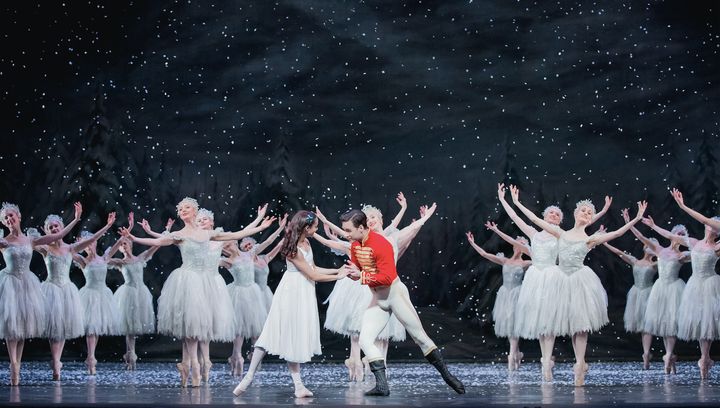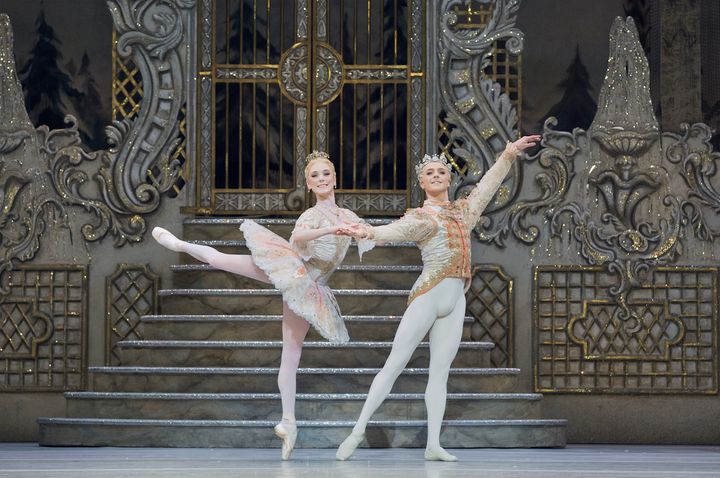Christmas wouldn’t be Christmas without bizarre gifts from relatives that leave you wondering, “Why?”
So perhaps it’s no coincidence that the world’s favorite Christmas ballet, The Nutcracker, centers around a young girl who gets wooden doll from her weird uncle, and suddenly finds herself on the sugar high of her life.

Francesca Hayward, Alexander Campbell and Royal Ballet artists in The Nutcracker
On the one hand, it’s easy to delight in the fine craftsmanship of the ballet, much as one might admire the stitching on a crazy aunt’s hand-knitted Christmas sweater. But on the other hand, and for better or for worse, the ’why’ behind the strange gift at the heart of the ballet is never addressed.
It is this question that The Royal Ballet takes on in Peter Wright’s much-beloved version of The Nutcracker, a chestnut of the company’s repertory since 1984. Unlike other productions I’ve seen, this version gives Drosselmeyer a motive for giving Clara the nutcracker, and thus adds more substance to the most saccharine of ballet tales.
We first meet Drosselmeyer (Gary Avis) in the prelude in his magical workshop, where he is preparing for the holidays with his wonderfully hammy assistant (David Yudes). A nutcracker stands beneath the portrait of a handsome youth, whom we learn is Drosselmeyer’s favorite nephew, Hans-Peter, who was transformed into a nutcracker under an evil spell. To break the spell, the nutcracker must defeat the Mouse King and win the love of a young girl. When Drosselmeyer is invited to a Christmas party by his friends, Clara’s parents, he hopes it will present the opportunity to lift the curse.
This background provides an engaging narrative thread that connects a memorable cast of main characters. As Clara, the superb Francesca Hayward conjures adolescence with refreshing authenticity (the real adolescence — not the dainty, coquettish, balletic sort). Combining dynamic playfulness with suspended moments of dreamy, floating melancholy, she strikes just the right balance between woman and child — a tough feat for a mature artist.
As the Nutcracker / Hans-Peter, Alexander Campbell is a worthy match for Hayward in terms of both dancing and acting. With an explosive jump and a tender touch in partnering, he is still charmingly boyish as he fights the Mouse King and flirts with Clara in the snow.

Sarah Lamb and Steven McRae in The Nutcracker
There’s no denying the chemistry between Hayward’s Clara and Campbell’s Hans-Peter, but the real love story in this version is between Drosselmeyer and his nephew, and Avis’ take on the old coot more than rises to the occasion. Beneath the swirling cape and impressive magic tricks is a loving uncle who misses his nephew, and their reunion at the end is truly touching.
These three central characters — who have much more prominent dancing roles than in other productions — lend substance to the story, making up for what many Nutcrackers lack. However, this version also struck me as lacking something that other Nutcrackers have. Though perfectly polished, it misses some sparkle — and not for lack of sequins, rhinestones or gilded sets.
Perhaps it’s just the English reserve, which is on full, powdered-wigged display in this production. The party scene is perfectly pleasant, but hardly boisterous, and the snowflakes decline Tchaikovsky’s invitation to escalate into a blizzard. The Act II divertissements give us a chance to see more of Clara and Hans-Peter, but the effort to weave them into the choreography often serves to diminish their dazzle, particularly in the Russian and Chinese numbers. And as the Sugar Plum Fairy and her prince, Sarah Lamb and Steven McRae are regal perfection, but their unflinching control and courtly restraint seem mismatched to the soul-stirring drama of the score.
In other Nutcrackers I’ve seen, each scene is so entertaining that it’s easy to forgive and even forget how weird the overarching narrative is. The story is more important in the Royal Ballet production because it’s harder to get swept away in the spectacle, but fortunately it’s up to the task. With its clever plot twists, beautiful sets and winning lead performances, it’s a holiday gift I’d happily open again.
Royal Ballet’s The Nutcracker runs at the Royal Opera House in London through January 10, 2018. For tickets and more information, visit http://www.roh.org.uk/.
